Researchers, businesses, and decision-makers are debating the rapid rise of natural fiber polymer composites (NFPC) in light of environmental concerns. Consequently, the study of NFPCs that contain bio-reinforcements is expanding. Once more, the ecological and financial benefits of such biological fibers have drawn attention in all composite sectors that produce parts for a variety of functions, such as the interiors of vehicles, buses, and railway coaches. As a result, sectors like the automotive, aerospace, marine, and construction industries are now working to develop NFPC. Furthermore, natural fiber is a viable substitute for synthetic fiber in the production of sustainable complex products due to its appealing qualities, including high strength, low density, renewability, sustainability, and environmental friendliness[1-2]. Despite having a number of innovative properties, NFPC's application areas are limited because of its high moisture absorption tendency and lower strength compared to designed fiber. However, by minimizing the aforementioned limitations, advancements in hybridization techniques and the use of inorganic bio-reinforcements made from biowaste have substantially broadened their application regions. The bio-fibers are combined with synthetic fibers like glass, carbon, kevlar, etc. in a single matrix during the hybridization process. Numerous studies have clearly shown that the inclusion of this designed fiber has altered the strength-carrying properties of NFPC while also reducing the tendency of the material to absorb moisture[3-4]. Again, adding inorganic bio-reinforcements like wood dust, basalt powder, coco-peat powder, wheat and rice husks, crab shells, fish scales, animal bones, etc. improves the mechanical properties of composites by lessening a material's propensity to absorb water[5-6].Along with the matrix, the fillers are also chosen to provide a good or rough surface quality, enhanced tribological qualities, and cost savings[7-8].
The potential for synthetic fibers to be stronger and more elastic than natural fibers is generally present[9-10]. Natural fibers, on the other hand, can endure form changes without splitting. The elongation at break of kenaf fiber was six times larger than that of glass fiber, according to published reports[11]. Bio-fiber is now more competitive with synthetic fiber due to its distinct qualities. The ability of the design engineer to particularly tailor the mechanical strength of composites for the needs of the product is once again shown to be made possible by the hybridization process. Synthetic fibers exceed natural fibers in terms of strength and durability. Bio-fibers, on the other hand, are inherently soft, non-abrasive, and machine-friendly. As a result, it is possible to combine natural and synthetic fibers. So, it is possible to create composite materials of superior quality while spending less money by blending natural and synthetic fibers[12-14]. Once more, it is discovered that the properties of hybrid composites are mainly influenced by the qualities of the matrix, the amount of fiber present, the relative volume of the fibers, the molding process, and the fiber-matrix interface[15]. Furthermore, even while loading is not the main factor, the hybridization of bio-fiber is more successful at reducing the use of synthetic fiber. Glass fiber is the least expensive of all the available man-made fibers, and it has excellent strength, resistance to chemical attacks, and good insulating qualities. Once more, it has strong wettability and can efficiently transform stress at the fiber-matrix interfaces. Glass fiber thus proved to be the ideal material for hybridization. According to a study conducted by Panthapulakkal et al.[16], adding glass to composites consisting of hemp and glass boosted their flexural strength from 97.5 MPa to 101 MPa. Zuhudi[17] found a similar upward trend in charpy impact resistance when they replaced 30% of the woven bamboo fibers with glass fiber in a bamboo/glass polypropylene composite, going from 530.9 J/m to 1129 J/m. The hybridization of long sugar palm and glass fiber in an epoxy matrix significantly boosts the impact strength up to 15 J, reported by Safri.[18] Begum's[19] investigation was done to ensure that a hybrid composite's volume proportion of bio- and synthetic fibers maintained the same mechanical strength. Similar to this, Tamrakar[20] stated that when comparing it to a plain glass fiber-reinforced composite, more kenaf fiber needed to be layered up with glass in order to reach equivalent density. Because the kenaf is stacked high, there is less void space. Sumesh[21] carried out the mechanical and physical characterization of the kenaf/glass hybrid composite. Similarly, Ramesh[22] had also reported a higher tensile and flexural strength at a combination of 40% kenaf and 60% glass fiber in the composites. Thus, the hybrid composite appeared to have intermediate mechanical and physical qualities, according to the results.
Again, the combination of natural and synthetic fibers enhances the composite's strength and dimensional stability when exposed to temperature changes and humid environments. The dimensional stability of a composite material is an important consideration when assessing its applicability for outdoor applications. Numerous factors, including fiber content, composite density, moisture absorption, thickness swelling, types of reinforcement, etc., are among the main determinants of dimensional stability[23]. Once more, the dimensional stability and load-bearing capacity of the composite can be altered by varying the amount of filler and the degree of filler dispersion in the matrix. Since the dynamical mechanical characteristics of composite materials are currently of significant interest to researchers, the combination of fillers and fiber reinforcement may boost those properties. Therefore, it is essential to change the composite filler reinforcement's strength. Shettar[24] found that adding nanoclay up to 5 wt% significantly enhanced the composite's mechanical properties. This may be the case due to nanoclay's outstanding properties, including its resistance to fracture formation, higher levels of plastic deformation, and stress-transforming nature. Once more, the work conducted by Karippal et al.[25] shows that the composite's enhanced stress transmission capabilities were improved by the inclusion of filler. The inclusion of nanoclay to the glass/epoxy composite allowed for this property enhancement. Thus, it can be concluded that the strength of composite materials is significantly influenced by the proportion of reinforcements.
Since fish is one of the most widely distributed aquatic species, fish scales are regarded as trash. Currently, 10 million tons of garbage from fish scales are generated annually. Such waste product disposal puts the environment at peril. It is crucial to utilize these waste products properly. Once more, the fish scale stands out among all conceivable bio-fillers due to its composition. Fish scales are now being used in the treatment of waste water to absorb ionic and non-ionic dyes[26]. The composite manufactured from fish scales is widely used in both the power and defense industries[27]. Once more, the addition of fish scale enhances the functionality of the composite while also lowering its cost and increasing its weight. Ramesh et al. [28] conducted a study to examine the effects of fish scale loading on the mechanical characteristics of polymer-based polymer composites. The results of the tests revealed that at a volume percentage of fish scale of 30%, composites had their best degree of tensile strength. The maximal flexural and impact strengths, however, were determined to be at 30% and 25% of the volume of the fish scale, respectively. The addition of fish scale to a polypropylene matrix resulted in similar enhancements in Young's modulus, bending strength, density, and hardness, according to Aradhyula[29]. Thermal deformation temperature, tensile strength, and tensile fracture, however, all showed a discernible decline. When describing the mechanical properties of the pusilla/carbon hybrid composites, Abhishek[30] found that the addition of 4% fish bone powder resulted in an extra increase in tensile strength of 22.5%. The experiment's findings demonstrated that, at volume fractions of 30%, 30%, and 25% of the fish scale, respectively, the tensile, flexural, and impact strengths were at their maximum levels. Similar to this, Nirmalraj et al.'s research [31] demonstrated that the addition of fish scale reduces the composite's capacity to absorb water.
There is still a need to investigate how bio-filler impacts the mechanical and dimensional stability of hybrid laminate structures, despite the fact that hybridization of fiber-reinforced composites has been the topic of numerous studies. Based on the aforementioned literature, the specific objective of the current work is to use dimensional analysis to assess the effect of fish scale filler on the mechanical and water absorption properties of a kenaf/glass hybrid laminate. In order to effectively employ this material in the production of panels for swimming pools, boat hulls, shower stalls, racing car bodies, etc., it is also required to examine the thickness and swelling qualities of the fabricated composite. Investigated is the morphology of shattered structures.
1 Materials and Method 1.1 Material UsedFor the purpose of creating laminates, Messrs Go Green Products Ltd., Chennai, India, sold glass and kenaf fiber mats with a plain weave (0°/90°) pattern. In comparison to glass fiber, which has a 0.25 mm thickness and a density of 2.55 g/cm3, kenaf fiber has a 0.5 mm thickness and 1.45 g/cm3 density. Unsaturated polyester resin of commercial quality, cobalt naphthenate as an accelerator, and methyl-ethyl-ketone-peroxide (MEKP) as a catalyst were all purchased locally. The features of reinforcements are listed in Table 1.
1.2 Preparations of Fish Scale Filler Powder
Scales from rohu fish were procured from the neighborhood markets in Burla, Sambalpur, India. To get rid of the dust, soluble surface contaminants, and organic coating that were on the fish scales, they were submerged in a hot water bath for a couple of hours. This significantly lessened the smell of the scales. The cleaned scales were left out in the open sun for three to four days to dry out and become crispy. The cleaned fish scales were then heated for three hours at 100 ℃ in a hot air furnace. With the aid of a flour mill, the fish scales were ground up after the moisture was removed. After passing through 200 and 300 mesh sieves, the powder was vacuum-dried for 10 h at 80 to 100 ℃, reducing the water content to below 0.05%. Fig. 1 shows the process of breaking down fish scales into powder step by step. Fish scale filler has a density of 900 kg/m3 [35].
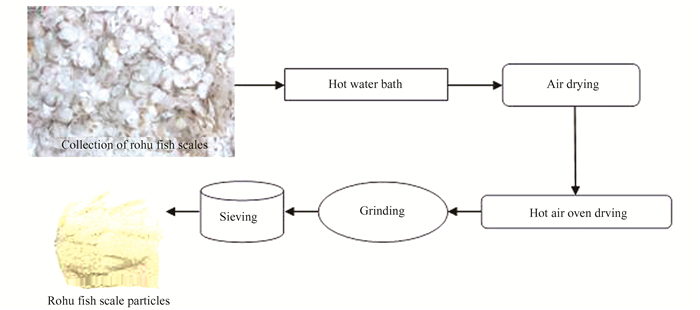
|
Fig.1 Details preparation of fish scale powder |
1.3 Preparation of Laminates
The usual hand-layup method was followed to fabricate composite laminates. Prior to preparing the laminates, a steel mold of dimension 200 mm×200 mm×5 mm was thoroughly cleaned with alcohol and polished with 800-grit sandpaper. Grade of 8082 silicone spray was used to coat the surface of the mold to keep casting materials from adhering. The woven glass and kenaf mats were cut to the fit of the mold's dimensions. A polyester mix was prepared by mixing adequate amount of unsaturated polyester resin and catalyst MEKP in the ratio of 10:1 with additional 2% accelerator. The polymer mix was stirred by the help of hand operated mechanical stirrer for 10 min to ensure uniform mixture. A preset quantity of fish scale powder was added to the polyester mixture as per the required weight percentages and stirred for five minutes with a same stirrer to ensure a consistent dispersion of fish scale particles throughout the polyester mix. The fixed dimensioned cut glass and kenaf mats were soaked in the filler mixed matrix for proper wetting of mats. A thin layer of filler mixed matrix was applied on the mould and soaked mats were placed as per the stacking order that presented in Table 2. The letters K and G mentioned in table stand for kenaf and glass fiber respectively. Small amount of matrix mixed was also applied in between the intermediate mats. After that, a gently rolling was performed by means of roller to remove any trapped air and extra polymer that present in between the layers. Finally, the steel cover plate was put over the mold under a load of 40 kg in order to compress the layers of laminate and squeeze out the extra polymer mix that present. The mould was kept in the laboratory environment for a period of 48 h at temperature of 30 ℃ -20 ℃. Then the laminates were removed from the mould and test specimens were cut to the required size by the help of a scroll saw (Fig. 2). The test specimens were stored in the desiccators.
| Table 2 Designation of composites |
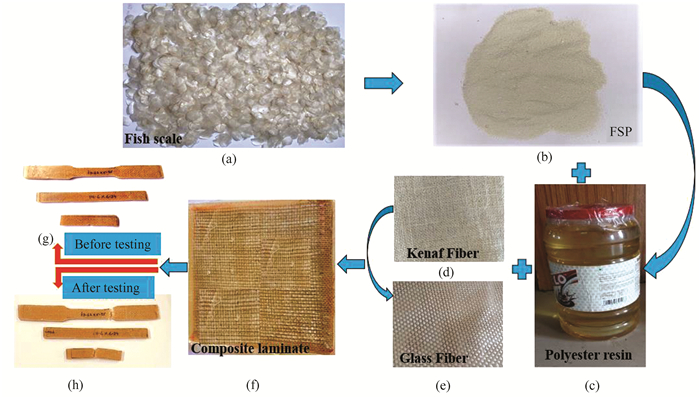
|
Fig.2 Details fabrication of composite laminates for testing |
1.4 Characterizations of Laminates 1.4.1 Density and voids content
Measurements were made of the actual density (a) and void content (Vv) of laminates in accordance with ASTM D1895 [36] and ASTM D-2734-70 standards [37]. The samples' densities and void contents were calculated using the following equations:
| $\rho_a=\frac{\text { Mass of laminates }(\mathrm{m})}{\text { Volume of laminates }(\mathrm{V})}$ | (1) |
| $V_v=\frac{\left(\rho_t-\rho_a\right) \times 100}{\rho_a}$ | (2) |
where ρt is the theoretical density of laminate, which was determined by using Rule of Mixture.
1.4.2 Study of moisture absorption and dimension stabilityMeasurements of moisture absorption and dimension stability in terms of swelling thickness were performed in accordance with ASTM D570-98 [38]. Five samples of each type of composite were utilized in the test. Before testing, the samples were oven-dried for two hours at 80 ℃, and when they had cooled to room temperature, they were tested. Once the samples had been oven-dried, they were kept in desiccators. We determined each sample's starting weight (W0) and average thickness (T0). After that, the samples were submerged in distilled water that had been heated in the lab to 302 ℃. After 24 h exposure period, the samples were taken out of the water, and any leftover water was cleaned off of every surface with tissue paper. Again, the weight (Wt) and average thickness (Tt) of each sample were determined and recorded. The process was carried out repeatedly until the moisture absorption equilibrium was reached or the weight change percentage dropped to less than 0.1%. The percentage moisture absorption (Mt) and thickness swelling (TS) with respect to time were calculated using the following equations:
| $M_{\mathrm{t}}=\frac{\left(W_{\mathrm{t}}-W_0\right) \times 100}{W_0}$ | (3) |
| $T_{\mathrm{S}}=\frac{\left(T_{\mathrm{t}}-T_0\right) \times 100}{T_0}$ | (4) |
The FS/KF/GF/polyester composites were examined for their tensile and flexural properties using a Universal Testing Machine (UTM) (INSTRON-3389, USA) with a low crosshead speed of 2 mm/min and in accordance with ASTM D 638-03[39] and ASTM D790 [40], respectively. The tensile and flexural specimens were made with dimensions of (165 mm, 13 mm, 5 mm) and (127 mm, 13 mm, 5 mm), respectively. For the three-point bend test and tensile test, the span length of 100 mm and gage length of 57 mm, respectively, were chosen. Impact testing were carried out utilizing Izod impact test equipment (SCD, S-1102, India) in accordance with ASTM D256[41] using a 25-J pendulum. After flexural, tensile, and impact strength tests on five samples of each laminate, the average value was calculated. An ASTM E384 compliant micro hardness tester (Matsuzawa, MMT-X7B, JAPAN) was used to measure hardness [42]. Each sample was tested five times with a load of 50 gf for a duration of 10 s in order to determine its hardness. Using field emission scanning electron microscopy (FE-SEM) (Carl Zeiss, Germany), the interior cracks, microstructure, and structure of the cracked surfaces of the FS/KF/GF/polyester composites were once more studied. The test samples were coated with a thin layer of gold to increase electrical conductivity prior to photographing the fracture surfaces.
2 Results and Discussion 2.1 Effect of FS Filler Content on Void Content and Density of LaminatesFig. 3 shows the results of the determination of the organized, manufactured composite laminates' theoretical and experimental densities. The incorporation of FS decreased the density of composite laminates, as seen in Fig. 3(a). The density of the laminates with 15% FS is reduced by 2.197%, resulting in a decrease in the weight of the laminates. With an increase in the percentage of fish scales from 0% to 15%, a linear reduction in voids content was also observed, going from 6.331% to 3.380%. The appropriate aggregation of fish scale powder in the polyester matrix during laminate preparation is responsible for the decrease in void content. The density changes of laminates containing 15% of FS is shown in Fig. 3(b) with an alternate stalking sequence. The GGGG-FS15 sample showed great density and had a minimum void content of 1.265%, while the KKKK-FS15 sample had a maximum void content of 7.488%. Due to a lack of wetting kenaf fiber, the KKKK-FS15 sample had a higher-than-average number of voids. The laminates with the glass layer at the outer surface (GKKG-FS15) had a minimum density of 1.211 gm/cm3 and a minimum void content of 2.656% when comparing the density and void content of laminates with the same number of glass and kenaf layers.
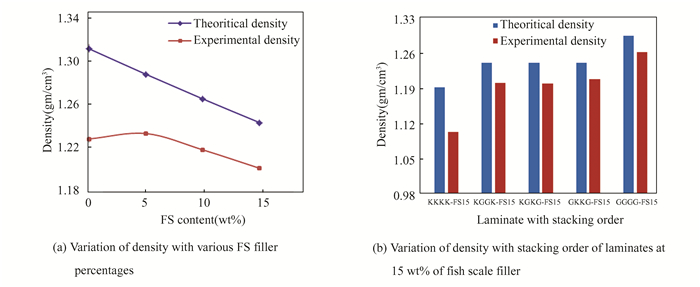
|
Fig.3 Density of FS filled composite and laminates with varying stacking order |
2.2 Influence of FS Filler on Moisture Absorption
In general, the elements that most frequently affect the moisture diffusion in a composite are the amount of fiber and filler, the presence of voids, the kind of fiber and filler, the size of the filler, the viscosity of the matrix, and the humidity and temperature of the surrounding air[43]. The water absorption patterns of the KGKG laminate with various FS filler percentages are shown in Fig. 4(a). Regardless of FS filler concentration, an initial increase in water absorption with immersion duration is seen, followed by a notable saturation in absorption after a specific amount of time. After examining the data, KGKG laminates without filler are shown to have the highest water absorption. Consequently, when the amount of FS filler increases, the proportion of water absorption decreases. For KGKG-FS0 and KGKG-FS15 laminates, respectively, a maximum value of water absorption of 5.402% and a minimum value of 4.910% are noted. Due to the FS filler's packed distribution and less hydrophilic nature, there is a decrease in water absorption as FS filler content increases. Once more, it is seen that as the concentration of FS filler increases, the time required for water to reach saturation decreases. Due to the 15% presence of FS filler as opposed to 0% FS filler reinforced KGKG laminates, the saturation time is reduced by 29.41%. Fig. 4(b) further illustrates how stalking order affects water absorption. Due to the larger concentration of hydrophilic fibers in the KKKK-FS15 laminate, a higher percentage of water absorption (7.610%) is observed. However, due to the hydrophobic nature of glass fiber, a minimal proportion of water absorption (3.097%) is seen in the case of GGGG-FS15 laminate. Among the laminates KGKG-FS15, GKKG-FS15, and KGGK-FS15, GKKG-FS15 exhibits the least amount of water absorption (4.265%) at the 14-day saturation point. The presence of glass fiber at the outer layer, which offers a resistance to water molecule penetration, may be the cause of this.
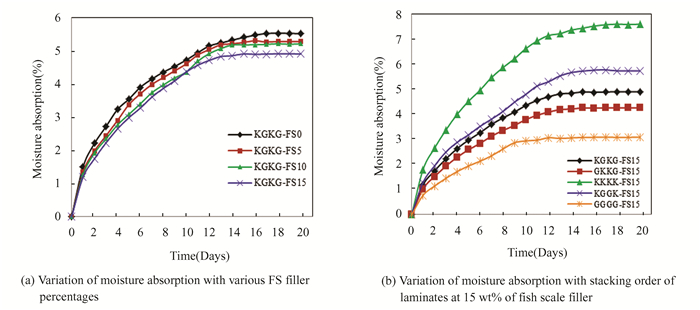
|
Fig.4 Moisture absorption of composites |
2.3 Influence of FS Filler on Dimensional Stability
A general sense of the composite's dimensional stability can be obtained from the percentage of thickness swelling with respect to time. When water absorption occurred, a stress was created between the laminate's layers, causing the fiber matrix interface to deteriorate and encouraging dimensional instability[44]. Fig. 5 shows the percentage change in thickness vs water absorption time for all composite laminates that have been manufactured. With an increase in moisture absorption exposure time, a rise in thickness swelling is seen. Fig. 5 (a) explores how the FS filler content affects the thickness swelling characteristics of the laminate. With a shorter saturation time of 11 days instead of 14, the greater FS filler content (15%) decreases the thickness swelling percentage by 22.39%. This extraordinary decrease in thickness swelling rate is a result of the FS filler's reduced hydrophilic characteristics and consistent, compact distribution throughout the polyester matrix. Similar to moisture absorption, the stalking sequence and kenaf/glass fiber content have an impact on the thickness swelling, as shown in Fig. 5(b). GKKG-FS15 among all manufactured laminates exhibits a minimum swelling percentage of 3.756% with an early saturation time of 14 days. As hydrophobic glass fiber is present on the outer layer of the laminate, decreased exposure of lignocellulosic kenaf fiber to water is to be predicted [45].
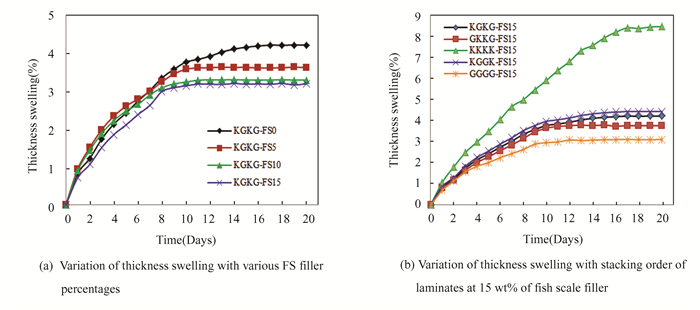
|
Fig.5 Thickness swelling of composites |
2.4 Influence of FS Filler on Mechanical Properties
The most crucial factor in influencing the mechanical performance of the materials is the bonding at the interface. The mechanical properties of hybrid kenaf/glass composites with filled FS filler are listed in Table 3. The modulus and tensile strength are shown in Fig. 6. Strength and modulus increase as FS filler content increases. It should be noticed that KG-FS15 has higher tensile strength (118.72 MPa) and modulus (8.296 GPa). The material's tensile properties have been improved by the constant distribution of FS filler across polyester resin[46].
| Table 3 Mechanical properties of FS filled KGKG polyester composite laminates |
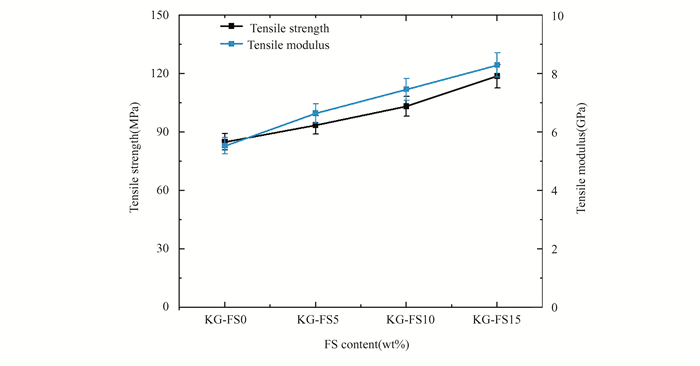
|
Fig.6 Tensile properties of composite laminates |
The flexural parameters, including flexural strength and modulus, are shown in Fig. 7. Even though the usage of FS filler varies from 0 to 10 weight percent, flexural properties are noticeably improved. The increase in flexural strength can be attributed to the fillers' enhanced dispersion and distribution within the polymer matrix, which successfully reduce chain moments during deformation. When compared to 10 weight percent of FS filler, the flexural strength and modulus are lower after 15 weight percent of filler by 5.94% and 17.47%, respectively. The fish scale filler clinging to the matrix and forming a weak interface is the cause of this [47].
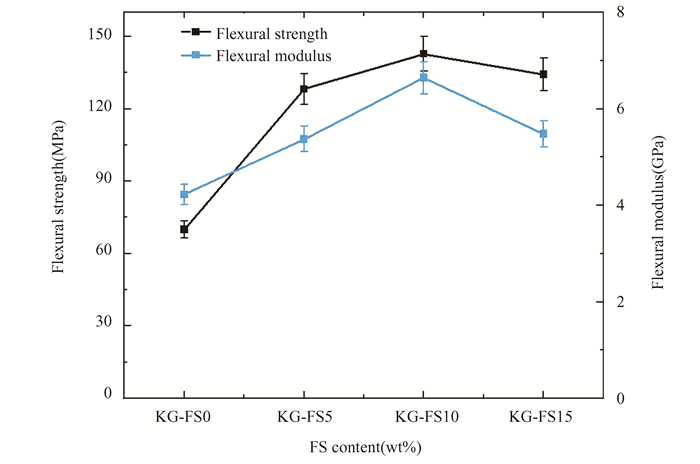
|
Fig.7 Flexural properties of composite laminates |
Izod impact strength is a measurement of a material's resistance to fracture under high-speed stress. The impact behavior of kenaf/glass hybrid composites filled with FS filler is also shown in Fig. 8. As the weight % of FS filler increases from 0 to 10 weight percentage, the impact attributes substantially improve. The composite KF-FS10 demonstrated the highest impact strength (62.08 kJ/m2) in comparison to KG-FS0. This is a result of the interfacial interaction between the matrix and filler being enhanced. The impact strength was lowered as a result of the addition of FS filler above a concentration of 10%, as shown in Fig. 8 by the inadequate stress transfer and degraded filler-matrix adhesion[48-49].
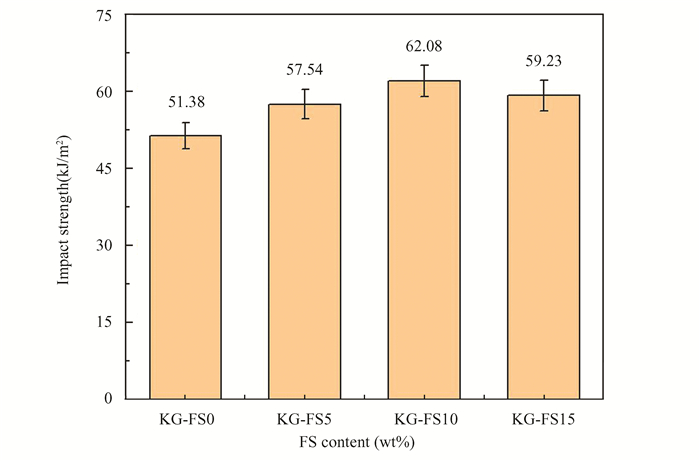
|
Fig.8 Impact strength of composite laminates |
The surface hardness of the composites is regarded to be one of the important factors affecting how well they can resist wear. The hardness behavior of FS-filled kenaf/glass composites is shown in Fig. 9. The graph demonstrates that the hardness rose together with the FS content, reaching a value of 17.82 HV for the KG-FS15 composites. The KG-FS15 composite demonstrated maximum hardness with a 26.11% increase over the KG-FS0 composite, as shown in Fig. 9. The decreased micro-voids and filler-polyester debonding in the interphase area brought on by the improved interfacial adhesion between the FS and polyester matrix are to blame for the composite's increase in hardness with more reinforcement[50-51].

|
Fig.9 Micro-hardness of composite laminates |
2.5 Influence of Stacking Order on Mechanical Properties
The variation in tensile strength for different stacking configurations of FS15 filled kenaf/glass polyester laminates is depicted in Fig. 10. It is clear that the addition of FS filler increases the strengths of all hybrid composites. The GGGG-FS15 laminate has a tensile strength of 184.67 MPa, while the KKKK-FS15 laminate has a tensile strength of 43.45 MPa. When the stacking order is altered, the tensile strength of the hybrid laminates is found to be at its highest in the KGKG-FS15 laminate. In comparison to laminates with glass on the inside, those with glass fiber on the exterior have a higher tensile strength. Because, glass fibers are superior to kenaf fibers in terms of stiffness, durability, and interlaminar strength.As a result, it cannot fail suddenly when a sustained load is applied. This might be due to the kenaf fiber's greater levels of lignin and hemicellulose, which prevent it from forging a solid bond with the matrix[52-53].
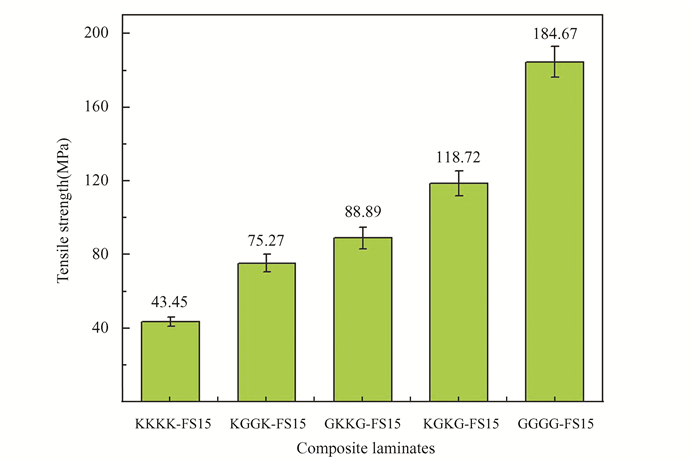
|
Fig.10 Tensile strength of FS15 filled hybrid kenaf-glass polyester composites |
The variation in flexural strength for different stacking arrangements of FS15-filled kenaf/glass polyester laminates is depicted in Fig. 11. It is clear that the addition of FS filler increases the strengths of all hybrid composites. The highest of the two laminates, the GGGG-FS15 laminate, has a flexural strength of 169.79 MPa, while the KKKK-FS15 laminate has a lower value of 48.73 MPa. When the stacking sequence was changed for the KGKG-FS15, it was revealed that the hybrid laminate's flexural strength was higher. Laminates with glass ply on the exterior layer offer better flexural value than those with glass in the inner layer. This could be caused by the passage of bending stress from the matrix to the glass fiber, which could support the load under loading conditions, as well as interphase interactions between the polymer and the fiber and between the filler and matrix[54]. The stacking sequence and fiber hybridization both affect the increase in strength.

|
Fig.11 Flexural strength of FS15 filled hybrid kenaf-glass polyester composites |
Fig. 12 displays the impact strength of hybrid kenaf/glass polyester composites filled with FS15. For GGGG-FS15 laminates, the maximum impact strength is found to be 63.52 kJ/m2, whereas KKKK-FS15 laminates have a lower impact strength of 35.26 kJ/m2. The hybrid laminates displayed higher impact values than the KKKK-FS15 laminate as a result of the addition of glass fiber layers. The findings showed that when the stacking orders were switched, the hybrid composite's impact strength was shown to be more significant in the KGKG-FS15. Its strength is 67.98% more than KKKK-FS15 laminate.Comparing composites with glass in the inner position to laminates with glass in the outer position, it is discovered that the latter have higher impact qualities. The impact strength of GKKG-FS15 is 7.81% higher than that of KGGK-FS15 laminate. The properties of the reinforcing fibers used in the composite, as well as the fiber-matrix and FS-matrix interfacial adhesion and interlaminar adhesion, all affect the impact strength[54].

|
Fig.12 Impact strength of FS15 filled hybrid kenaf-glass polyester composites |
Fig. 13 shows the toughness of hybrid kenaf/glass polyester composites filled with FS15. According to the Fig. 13, the maximum hardness of the GGGG-FS15 laminate is 22.5 HV, compared to 12.24 HV for the KKKK-FS15 laminate. While switching the stacking order of kenaf and glass ply with KKKK-FS15 laminate, there is a significant improvement of 45.58% in hardness. It is discovered that the composite with glass on the exterior side (KGGK-FS15) has a harder surface than the laminate with glass on the external side (GKKG-FS15), which is 4.54% harder. This might be the result of improved interaction between the reinforcement and matrix. The interparticle spacing reduces as the particle loading in the matrix rises, increasing the resistance to indentation. As a result, the filler and matrix phases would be compressed and come closer together. The contact can transmit a load more effectively as a result. The hardness may have increased as a result[50].
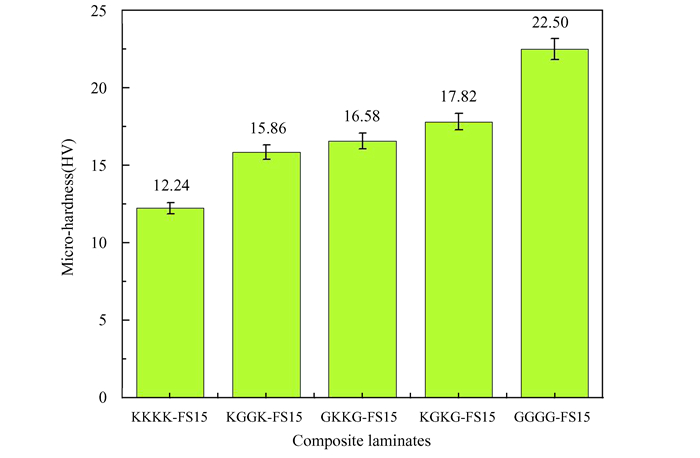
|
Fig.13 Micro-hardness of FS15 filled hybrid kenaf-glass polyester composites |
2.6 Thermogravimetric (TGA) Analysis
The TGA plot for composite materials is shown in Fig. 14. As depicted in the image, this thermal research was conducted at temperatures ranging from 25 ℃ to 700 ℃. All composite samples exhibit a consistent pattern of mass loss up to 300 ℃. Due to the moisture in the natural fibers, there is a slight weight loss during the initial heating phase, which lasts up to 100 ℃[55]. It is difficult to eliminate the hydroxyl content without affecting the cellular structure since it has a tendency to persist within cell walls. Due of cellulose's attraction for OH groups, samples with higher cellulose concentrations have higher moisture contents. KKKK-FS15 loses weight more quickly than other composites, frequently beginning at 350 ℃. The lack of glass fiber, which would help to increase thermal resistance, is linked to this behavior. It is known that glass fibers typically have a greater thermal degradation temperature threshold than kenaf fibers. The subsequent weight loss phase is caused by the breakdown of cellulose and hemicellulose components and occurs between 200 ℃ and 350 ℃. The presence of lignocellulose content is thought to be responsible for this particular temperature range[56]. For the GGGG-FS15 laminate, a significant 82% residue was present at 330 ℃, and this residue decreased to 34.05% at 700 ℃. It is possible to attribute the reduction in final residue to improved bonding, which stopped further degradation. The KGKG-FS15 composites, on the other hand, showed a residual of 27.81% at 700 ℃. The effective interfacial connection between the FS filler and matrix and the presence of lignin in KF are both responsible for the observed residue. The KKKK-FS15 laminate showed a residue concentration of 23.27% at 700 ℃, which may have been caused by insufficient kenaf fiber attachment to the matrix. Evidently, as the temperature rose, all specimens lost weight as a result of the heat degradation of hemicellulose, lignin, pectin, and the cellulose's internal glycosidic linkages[57]. Additionally, as seen in Fig. 14, the GGGG-FS15 laminate had the largest residual content at 700 ℃, whereas the KKKK-FS15 laminate's residue content was noticeably lower. This difference could be explained by the glass fiber's higher compatibility with both the matrix and the filler components as well as its ability to tolerate high temperatures.
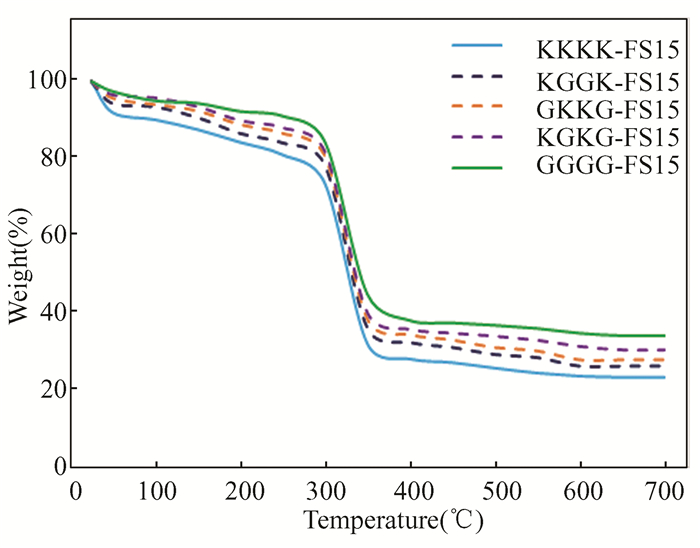
|
Fig.14 TGA thermogram for FS15 filled hybrid kenaf/glass polyester composites |
2.7 Fractography Study
The fracture surface morphology of test samples is examined using scanning electron microscopy (SEM). Fig. 15(a) shows the fracture surface morphology of KKKK-FS15 sample subjected tensile test. The SEM picture revealed the fiber fracture with very small pullout. This fact evident the reason of maximum tensile strength due to strong interfacial bonding between fiber and matrix. Fig. 15(b) reflects the fracture surface morphology of GGGG-FS15 laminate in flexural test, where fiber fracture is more prominent. In this case, the fiber fracture and fiber breaking are the major criterion of failure. However, Fig. 15(c) evident, the shear yielding is one of the most major factors for failure during flexural test of the KKKK-FS15 composite. An agglomeration of polyester-coated FS filler particles and micro-voids are also marked. These micro-voids that present are mainly responsible for reduction in strength of laminates. In case of KGKG-FS15 laminate, the brittle failure of glass fiber and pull-out of kenaf fiber are clearly visible in the micrograph as shown in Fig. 15(d), which evident a good adhesion between the fiber/matrix and filler/matrix. This strong adhesion between fiber and filler with matrix resulted an enhanced bending strength in the laminates.

|
Fig.15 Sem micrograph of (a) KKKK-FS15, (b) GGGG-FS15 laminates under tensile loading, (c) KKKK-FS15, (d) KGKG-FS15 under flexural loading |
3 Conclusions
The present work basically focused on the effective use of abundantly available fish scale (FS) for developing sustainable composite material. The experimental findings revealed that, the successive addition of FS filler significantly improved the mechanical properties of kenaf/glass hybrid polymer laminates. A peak value of tensile strength and hardness of 118.72 MPa and 17.82 HV respectively was marked at filler loading of 15wt% in KGKG laminates. However, maximum flexural strength of 142.77 MPa and impact strength of 62.08 kJ/m2 was obtained at 10 wt% of filler loading in same laminates. Again, regardless of the stacking sequence, an increase in all the properties of laminates was noticed with subsequent inclusion of FS filler. Further, the addition of FS filler significantly improved the dimensional stability of the laminates in moist environment by reducing the moisture absorption tendency. This explores the usages of this laminates as structural as well as building materials in open environment. This study contributes to a foundational understanding of FS filler preparation, laminate fabrication techniques, and testing procedures. Different fabrication technique and fiber modification methods can be proposed to derive an effective laminate with enhanced strength.
| [1] |
Madhu P, Sanjay M R, Senthamaraikannan P, et al. A review on synthesis and characterization of commercially available natural fibers: Part-Ⅰ. Journal of Natural Fibers, 2019, 16(8): 1132-1144. DOI:10.1080/15440478.2018.1453433 (  0) 0) |
| [2] |
Yashas Gowda T G, Sanjay M R, Subrahmanya Bhat K, et al. Polymer matrix-natural fiber composites: An overview. Cogent Engineering, 2018, 5(1): 1446667. DOI:10.1080/23311916.2018.1446667 (  0) 0) |
| [3] |
Sathish S, Ganapathy T, Bhoopathy T. Experimental testing on hybrid composite materials. Applied Mechanics Materials, 2014, 592: 339-343. DOI:10.4028/www.scientific.net/AMM.592-594.339 (  0) 0) |
| [4] |
Rajak D K, Pagar D D, Menezes P L, et al. Fiber-reinforced polymer composites: Manufacturing, properties, and applications. Polymers (Basel), 2019, 11(10): 1667. DOI:10.3390/polym11101667 (  0) 0) |
| [5] |
Aveen K P, Bhajantri V, D*Souza R, et al. Experimental analysis on effect of various fillers on mechanical properties of glass fiber reinforced polymer composites. AIP Conference Proceedings, 2019, 2057(1): 1-6. DOI:10.1063/1.5085615 (  0) 0) |
| [6] |
Ibrahim M, Labaki M, Giraudon J M, et al. Hydroxyapatite, a multifunctional material for air, water and soil pollution control: A review. Journal of Hazardous Materials, 2020, 383. DOI:10.1016/j.jhazmat.2019.121139 (  0) 0) |
| [7] |
Gupta A, Singh H, Walia R S. Effect of fillers on tensile strength of pultruded glass fiber reinforced polymer composite. Indian Journal of Engineering and Materials Sciences, 2015, 22(1): 62-70. (  0) 0) |
| [8] |
Feyzullahoǧlu E. Effect of different fillers on adhesive wear properties of glass fiber reinforced polyester composites. Tribology in Industry, 2017, 39(4): 482-486. DOI:10.24874/ti.2017.39.04.07 (  0) 0) |
| [9] |
Pickering K L, Efendy M G A, Le T M. A review of recent developments in natural fibre composites and their mechanical performance. Composites Part A: Applied Science and Manufacturing, 2016, 83: 98-112. DOI:10.1016/j.compositesa.2015.08.038 (  0) 0) |
| [10] |
Ammar I M, Huzaifah M R M, Sapuan S M, et al. Development of Sugar Palm Fiber Reinforced Vinyl Ester Composites. Cambridge: Woodhead Publishing, 2018, 11: 211-224. DOI:10.1016/B978-0-08-102160-6.00011-1 (  0) 0) |
| [11] |
Sharba M J, Leman Z, Sultan M T H, et al. Effects of kenaf fiber orientation on mechanical properties and fatigue life of glass/kenaf hybrid composites. BioResources, 2016, 11(1): 1448-1465. (  0) 0) |
| [12] |
Yahaya R, Sapuan S M, Jawaid M, et al. Water absorption behaviour and impact strength of Kenaf-Kevlar reinforced epoxy hybrid composites. Composites and Advanced Materials Letter, 2016, 25: 98-102. DOI:10.1177/096369351602500403 (  0) 0) |
| [13] |
Nallusamy S, Majumdar G. Effect of stacking sequence and hybridization on mechanical properties of Jute-Glass fiber composites. International Journal of Performability Engineering, 2016, 12(3): 229-239. DOI:10.23940/ijpe.16.3.p229.mag (  0) 0) |
| [14] |
Ramesh M. Kenaf (Hibiscus cannabinus L.) fibre based bio-materials: A review on processing and properties. Progress in Materials Science, 2016, 78-79: 1-92. DOI:10.1016/j.pmatsci.2015.11.001 (  0) 0) |
| [15] |
Almeida J H S, Amico S C, Botelho E C, et al. Hybridization effect on the mechanical properties of curaua/glass fiber composites. Composites Part B: Engineering, 2013, 55: 492-497. DOI:10.1016/j.compositesb.2013.07.014 (  0) 0) |
| [16] |
Panthapulakkal S, Sain M. Injection-molded short hemp fiber/glass fiber-reinforced polypropylene hybrid composites—mechanical, water absorption and thermal properties. Journal of Applied Polymer Science, 2007, 103: 2432-2441. DOI:10.1002/app.25486 (  0) 0) |
| [17] |
Zuhudi N Z M, Lin R J T, Jayaraman K. Flammability, thermal and dynamic mechanical properties of bamboo-glass hybrid composites. J Thermoplast Compos Mater, 2016, 29: 1210-1228. DOI:10.1177/0892705714563118 (  0) 0) |
| [18] |
Safri S N A, Sultan M T H, Jawaid M, et al. Analysis of dynamic mechanical, low-velocity impact and compression after impact behaviour of benzoyl treated sugar palm/glass/epoxy composites. Composites Structure, 2016, 226: 111308. DOI:10.1016/j.compstruct.2019.111308 (  0) 0) |
| [19] |
Begum K, Islam M A. Natural fiber as a substitute to synthetic fiber in polymer composites: A review. Research Journal of Engineering Sciences, 2013, 2: 46-53. (  0) 0) |
| [20] |
Tamrakar S, Kiziltas A, Mielewski D, et al. Characterization of kenaf and glass fiber reinforced hybrid composites for underbody shield applications. Composites Part B: Engineering, 2021, 216: 108805. DOI:10.1016/j.compositesb.2021.108805 (  0) 0) |
| [21] |
Sumesh K R, Kanthavel K. Grey relational optimization for factors influencing tensile, flexural, and impact properties of hybrid sisal banana fiber epoxy composites. Journal of Industrial Textiles, 2022, 51: 4441S-4459S. DOI:10.1177/1528083720928501 (  0) 0) |
| [22] |
Ramesh M, Nijanthan S, Palanikumar K. Processing and mechanical property evaluation of kenaf-glass fiber reinforced polymer composites. Applied Mechanics Materials, 2015, 766-767: 187-192. DOI:10.4028/www.scientific.net/AMM.766-767.187 (  0) 0) |
| [23] |
Taib M N A M, Julkapli N M. Dimensional Stability of Natural Fiber-based and Hybrid Composites. Cambridge: Woodhead Publishing, 2018, 4: 61-79. DOI:10.1016/B978-0-08-102292-4.00004-7 (  0) 0) |
| [24] |
Shettar M, Kowshik C S S, Manjunath M, et al. Experimental investigation on mechanical and wear properties of nanoclay-epoxy composites. J Mater Res Technol, 2020, 9(4): 9108-9116. DOI:10.1016/j.jmrt.2020.06.058 (  0) 0) |
| [25] |
Karippal J J, Murthy H N N, Rai K S, et al. Study of mechanical properties of epoxy/glass/nanoclay hybrid composites. Journal of Composites Materials, 2011, 45(18): 1893-1899. DOI:10.1177/0021998310389087 (  0) 0) |
| [26] |
Chowdhury S, Das Saha P, Ghosh U. Fish (Labeo rohita) scales as potential low-cost biosorbent for removal of malachite green from aqueous solutions. Bioremediation Journal, 2012, 16(4): 235-242. DOI:10.1080/10889868.2012.731444 (  0) 0) |
| [27] |
Vernerey F J, Musiket K, Barthelat F. Mechanics of fish skin: A computational approach for bio-inspired flexible composites. International Journal of Solids Structures, 2014, 51(1): 274-283. DOI:10.1016/j.ijsolstr.2013.10.001 (  0) 0) |
| [28] |
Ramesh Babu K, Jayakumar V, Bharathiraja G, et al. Experimental investigation of fish scale reinforced polymer composite. Materialstoday: Proceedings, 2020, 22: 416-418. DOI:10.1016/j.matpr.2019.07.594 (  0) 0) |
| [29] |
Aradhyula T V, Bian D, Reddy A B, et al. Compounding and the mechanical properties of catla fish scales reinforced-polypropylene composite-from biowaste to biomaterial. Advanced Composite Materials, 2020, 29(2): 115-128. DOI:10.1080/09243046.2019.1647981 (  0) 0) |
| [30] |
Abhishek S, Sanjay M R, George R, et al. Development of new hybrid Phoenix pusilla /carbon/fish bone filler reinforced polymer composites. J Chinese Advanced Materials Society, 2018, 6(4): 553-560. DOI:10.1080/22243682.2018.1522599 (  0) 0) |
| [31] |
Nirmalraj L, Arun L, Manikandan S, et al. Investigation of mechanical properties in polymer based composite materials using fish scale and chicken feather reinforcement. International Journal for Scientific Research and Development, 2018, 6: 1500-1505. (  0) 0) |
| [32] |
Koc U, Aykut Y, Eren R. Natural fibers woven fabric reinforced hydrogel composites for enhanced mechanical properties. Journal of Industrial Textiles, 2022, 51(4-supp1): 6315S-6332S. DOI:10.1177/1528083720944485 (  0) 0) |
| [33] |
Ku H, Wang H, Pattarachaiyakoop N, et al. A review on the tensile properties of natural fiber reinforced polymer composites. Composites Part B: Engineering, 2011, 42(4): 856-873. DOI:10.1016/j.compositesb.2011.01.010 (  0) 0) |
| [34] |
Mahjoub R, Yatim J M, Mohd Sam A R, et al. Tensile properties of kenaf fiber due to various conditions of chemical fiber surface modifications. Construction and Building Materials, 2014, 55: 103-113. DOI:10.1016/j.conbuildmat.2014.01.036 (  0) 0) |
| [35] |
Ayyanar C B, Marimuthu K, Gayathri B. Characterization and in vitro cytotoxicity evaluation of fish scale and seashell derived nano-hydroxyapatite high-density polyethylene composite. Polymers and Polymer Composites, 2021, 29: 1534-1542. DOI:10.1177/0967391120981551 (  0) 0) |
| [36] |
ASTM D1895-96. Standard test method for apparent density, bulk factor, and pourability of plastic materials. ASTM International, 2003. 1-2. https://www.astm.org/d1895-17.html.
(  0) 0) |
| [37] |
ASTM D2734-94. Standard test method for void content of reinforced plastics. ASTM International, 2003.1-2. https://www.astm.org/d2734-16.html.
(  0) 0) |
| [38] |
ASTM D570-98. Standard test method for water absorption of plastics. ASTM International, 2003.1-2. https://www.astm.org/d0570-22.html.
(  0) 0) |
| [39] |
ASTM D638-03. Standard test method for tensile properties of plastics. ASTM International, 2006.1-15. https://www.astm.org/d0638-14.html.
(  0) 0) |
| [40] |
ASTM D790-15. Standard test method for flexural properties of unreinforced and reinforced plastics and electrical insulation materials. ASTM International, 2015.1-11. https://www.astm.org/d0790-17.html.
(  0) 0) |
| [41] |
ASTM D256-10. Standard test methods for determining the Izod pendulum impact resistance of plastics. American Society for Testing and Materials, 2007.1-20. https://www.astm.org/d0256-10r18.html.
(  0) 0) |
| [42] |
ASTM E384-17. Standard test method for microindentation hardness of materials. ASTM International, 2017.1-12. https://www.astm.org/e0384-22.html.
(  0) 0) |
| [43] |
Dhakal H N, Zhang Z Y, Richardson M O W. Effect of water absorption on the mechanical properties of hemp fibre reinforced unsaturated polyester composites. Compos Sci Technol, 2007, 67: 1674-1683. DOI:10.1016/j.compscitech.2006.06.019 (  0) 0) |
| [44] |
Fang T W, Asyikin N S S N, Shawkataly A K H P, et al. Water absorption and thickness swelling of Oil Palm Empty Fruit Bunch (OPEFB) and seaweed composite for soil erosion mitigation. Journal of Physical Science, 2017, 28(2): 1-17. DOI:10.21315/jps2017.28.2.1 (  0) 0) |
| [45] |
Khalil A, Khalil H P S A, Jawaid M, et al. Woven hybrid composites: water absorption and thickness swelling behaviors. BioResources, 2011, 6(2): 1043-1052. DOI:10.15376/biores.6.2.1043-1052 (  0) 0) |
| [46] |
Raghavendra G, Ojha S, Acharya S K, et al. Evaluation of mechanical behaviour of nanometer and micrometer fly ash particle-filled woven bidirectional jute/glass hybrid nanocomposites. Journal of Industrial Textile, 2016, 45: 1268-1287. DOI:10.1177/1528083714557058 (  0) 0) |
| [47] |
Raghavendra G, Ojha S, Acharya S K, et al. Influence of micro/nanofiller alumina on the mechanical behavior of novel hybrid epoxy nanocomposites. High Perform Polym, 2015, 27: 342-351. DOI:10.1177/0954008314550889 (  0) 0) |
| [48] |
Jani S P, Kumar A S, Khan M A, et al. Influence of natural filler on mechanical properties of hemp/kevlar hybrid green composite and analysis of change in material behavior using acoustic emission. Journal of Natural Fibers, 2021, 18(11): 1580-1591. DOI:10.1080/15440478.2019.1692321 (  0) 0) |
| [49] |
Jagadeesan R, Suyambulingam I, Divakaran D, et al. Novel sesame oil cake biomass waste derived cellulose micro-fillers reinforced with basalt/banana fibre-based hybrid polymeric composite for lightweight applications. Biomass Convers Biorefinery, 2023, 13: 4443-4458. DOI:10.1007/s13399-022-03570-2 (  0) 0) |
| [50] |
Kaundal R. Utilization of flyash as filler material in hybrid polyester composites for improved thermo-mechanical and erosion wear behavior. Silicon, 2018, 10: 2439-2452. DOI:10.1007/s12633-018-9776-5 (  0) 0) |
| [51] |
Ramesh V, Karthik K, Arunkumar K, et al. Effect of sawdust filler with kevlar/basalt fiber on the mechanical properties epoxy-based polymer composite materials. Materialstoday: Proceedings, 2022, 72: 2225-2230. DOI:10.1016/j.matpr.2022.09.208 (  0) 0) |
| [52] |
Negi A S, Katiyar J K, Kumar S, et al. Physicomechanical and abrasive wear properties of hemp/Kevlar/carbon reinforced hybrid epoxy composites. Mater Res Express, 2019, 6(11): 115304. DOI:10.1088/2053-1591/ab438d (  0) 0) |
| [53] |
Das S C, Paul D, Grammatikos S A, et al. Effect of stacking sequence on the performance of hybrid natural/synthetic fiber reinforced polymer composite laminates. Compos Struct, 2021, 276: 114525. DOI:10.1016/j.compstruct.2021.114525 (  0) 0) |
| [54] |
Salman S D, Leman Z, Sultan M T H, et al. Kenaf/Synthetic and Kevlar ©/Cellulosic fiber-reinforced hybrid composites: A review. BioResources, 2015, 10: 8580-8603. DOI:10.15376/biores.10.4.Salman (  0) 0) |
| [55] |
Xie Y, Hill C A S, Xiao Z, et al. Silane coupling agents used for natural fiber/polymer composites: A review. Composites Part A: Applied Science and Manufacturing, 2010, 41(7): 806-819. DOI:10.1016/j.compositesa.2010.03.005 (  0) 0) |
| [56] |
Yao F, Wu Q, Lei Y, et al. Thermal decomposition kinetics of natural fibers: Activation energy with dynamic thermogravimetric analysis. Polym Degrad Stab, 2008, 93: 90-98. DOI:10.1016/j.polymdegradstab.2007.10.012 (  0) 0) |
| [57] |
Aisyah H A, Paridah M T, Sapuan S M, et al. Thermal properties of woven Kenaf/Carbon fibre-reinforced epoxy hybrid composite panels. International Journal of Polymer Science, 2019, 2019: Article ID 5258621. DOI:10.1155/2019/5258621 (  0) 0) |
 2024, Vol. 31
2024, Vol. 31


